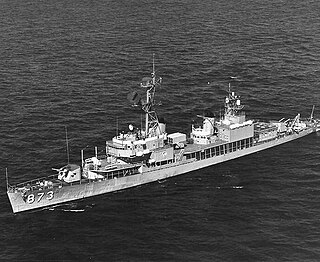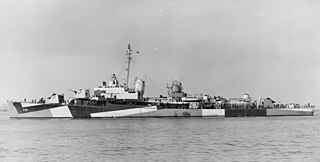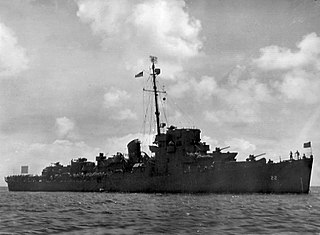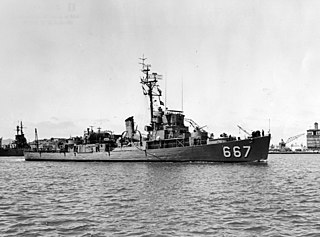
USS Ault (DD-698) was an Allen M. Sumner-class destroyer in the United States Navy. She was named for Commander William B. Ault, air group commander aboard Lexington. Commander Ault was declared missing in action on 8 May 1942 after leading an air attack in the Battle of the Coral Sea and was posthumously awarded the Navy Cross for his action in the battle.

USS Jacob Jones (DD-130), named for Commodore Jacob Jones USN (1768–1850), was a Wickes-class destroyer. She was sunk by a German submarine in 1942 during World War II.

USS Hawkins (DD-873) was a Gearing-class destroyer in the United States Navy during World War II. Following the war, the ship saw service in the Korean War and in the 1970s, was transferred to the Republic of China Navy as Tze Yang. She remained in service until the 1990s. The ship was then scrapped with the exception of her superstructure, which became part of a display and training ground at the Zuoying Naval Academy.

USS Picuda (SS-382), a Balao-class submarine, was originally named Obispo, making her the only ship of the United States Navy to be named for the obispo, a spotted sting ray.

USS Du Pont (DD–152) was a Wickes-class destroyer in the United States Navy during World War II, later reclassified as AG-80. She was the second ship named for Rear Admiral Samuel Francis Du Pont.

The first USS Macdonough (DD-9) was a Lawrence-class destroyer, which was a sub-class of Bainbridge-class destroyer, in the United States Navy. She was named for Commodore Thomas Macdonough
USS Dallas (DD-199) was a Clemson-class destroyer in the United States Navy during World War II. She was the second ship named for Captain Alexander J. Dallas, and was later renamed Alexander Dallas.

USS Isherwood (DD-284) was a Clemson-class destroyer in service with the United States Navy from 1919 to 1930. She was scrapped in 1931.

USS Litchfield (DD-336/AG-95) was a Clemson-class destroyer in the United States Navy following World War I.

USS Willard Keith (DD-775), an Allen M. Sumner-class destroyer, is currently the only completed ship of the United States Navy ever named for Willard Keith, a United States Marine Corps captain who died in combat during the campaign for Guadalcanal. He was awarded the Navy Cross for his actions.

USS James C. Owens (DD-776), an Allen M. Sumner-class destroyer, is the only ship of the United States Navy FRAM II class to be named for Lieutenant James C. Owens Jr., a member of Torpedo Squadron 8 on board USS Hornet. His entire squadron was lost in an attack against Japanese aircraft carriers 4 June during the Battle of Midway. Lt. Owens received the Navy Cross and the Presidential Unit Citation (US) posthumously.

USS William R. Rush (DD/DDR-714) was a Gearing-class destroyer in the United States Navy. She was named for William R. Rush.

USS William M. Wood (DD/DDR-715) was a Gearing-class destroyer in the United States Navy during the final year of World War II. She was in commission for 31 years, from 1945 through 1976, serving in both the Pacific and Atlantic Fleets. She was the second Navy ship named for Navy Surgeon-General William M. Wood (1809–1880).

USS Turner (DD/DDR-834) was a Gearing-class destroyer of the United States Navy, the third Navy ship named for Captain Daniel Turner (1794?–1850).

USS Robert H. McCard (DD-822) was a Gearing-class destroyer of the United States Navy, named for United States Marine Corps Gunnery Sergeant Robert H. McCard (1918–1944), who was posthumously awarded the Medal of Honor for conspicuous gallantry during the Battle of Saipan.

USS Wileman (DE-22) was an Evarts-class destroyer escort constructed for the United States Navy during World War II. It was promptly sent off into the Pacific Ocean to protect convoys and other ships from Japanese submarines and fighter aircraft. At the end of the war, she returned to the United States proudly displaying four battle stars.

USS Tills (DE-748) was a Cannon-class destroyer escort in service with the United States Navy from 1944 to 1946 and from 1950 to 1968. She was sunk as a target in 1969.

USS Woodson (DE-359) was a John C. Butler-class destroyer escort acquired by the United States Navy during World War II. The primary purpose of the destroyer escort was to escort and protect ships in convoy, in addition to other tasks as assigned, such as patrol or radar picket.

USS Wiseman (DE-667) was a Buckley-class destroyer escort in service with the United States Navy for several periods between 1944 and 1973. She was scrapped in 1974.

USS Bassett (APD-73), ex-DE-672, was a United States Navy high-speed transport in commission from 1945 to 1946 and from 1950 to 1957.



















